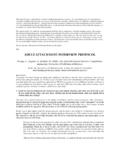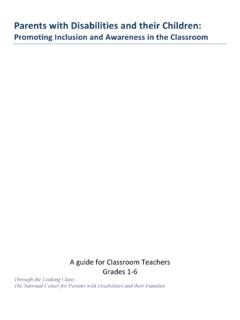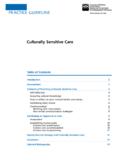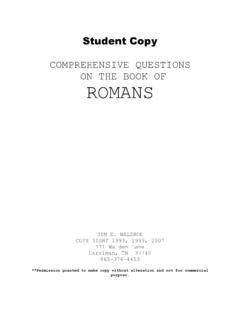Transcription of PICTURE DESCRIPTION - ENGLISHCENTER
1 PICTURE DESCRIPTION GUIDELINES, TECHNIQUES & EXAM TIPS M CRISTINA C. B. [A o] PICTURE DESCRIPTION A PICTURE DESCRIPTION is an ideal way of practising your English vocabulary in all sorts of fields. Pictures provide serious language practice and can be invaluable in the classroom for stimulating discussion and bringing enormous variety to lessons. They also provide the teacher with a flexible and convenient tool to test many different things in exams. GUIDELINES, TECHNIQUES & EXAM TIPS Here you have some techniques and exam tips I have put together to help you describe a PICTURE or photograph.
2 Study them carefully and decide on how to structure your PICTURE DESCRIPTION . Don t worry if you find it a bit difficult at first, we ll practise a lot to make things easier in time. I ve also included some exercises that we ll correct in a future revision class. After all, as the saying has it: A PICTURE paints aA PICTURE paints aA PICTURE paints aA PICTURE paints a thousand wordsthousand wordsthousand wordsthousand words M. Cristina C. B. IN THE IT LOOKS IN THIS LET ME AS I SEE IT AT THE QUESTIONS What happens when I have to describe a PICTURE ? It s simple. The examiner gives you a PICTURE and asks you to say what you see. He or she may also ask you to give an opinion or comment on the content of the PICTURE . What does this test? That depends on what the examiner is looking for.
3 It can test fluency, vocabulary, stress, pronunciation and rhythms of speech, ability to communicate, grammatical accuracy and interactive communication. And probably it can test them all at the same time. How should I approach this type of test? Here are some useful techniques and guidelines for describing pictures. You will not need to use all of them every time but it will be useful to be familiar with them. GUIDELINES TECHNIQUES 1. describe where things are in the PICTURE Make sure you are familiar with the language used to describe where something is in a PICTURE . Check that you know how to use the phrases in the boxes below: IN THE TOP AT THE TOP IN THE TOP LEFT (-HAND) RIGHT (-HAND) CORNER CORNER ON THE LEFT (-HAND) IN ON THE RIGHT (-HAND) SIDE THE SIDE MIDDLE IN THE BOTTOM IN THE BOTTOM LEFT (-HAND) RIGHT (-HAND)
4 CORNER AT THE BOTTOM CORNER IN THE BACKGROUND FOREGROUND Fill in the gaps with the correct position language: 1. _____ 2. _____ 3. _____ 4. _____ 5. _____ 6. _____ 7. _____ 8. _____ 9. _____ DO DON T Look carefully at the photos. Think how to describe what you can see. Take your time to do it. Be as precise as you can when you describe the photo itself. Use some position language if it helps. Use present continuous verbs to describe what is happening. If there is a person or people in the photo, you will need to describe their appearance. Answer questions as fully as possible. Keep talking, give details, explain your point, ask questions, paraphrase, don t get stuck on Any device that demonstrates that you can carry a topic through will help your performance.
5 Try to direct the conversation towards something you are interested in and can talk about easily. Speak naturally and be animated! Keep eye contact with the examiner, be friendly and show a positive attitude. Don t worry if you don t understand immediately what is going on in the PICTURE . Don t worry if you don t know the precise words for what you can see; use alternatives. Don t use the present simple to describe what is happening. Don t use general language to describe people. You should use vocabulary of the level required. Don t give too many one - or two word answers. Avoid answers which are single words or lists. Silence is you enemy! If you are not a talkative person by nature, you must make an extra effort for the test.
6 Don t feel you have to stick rigidly to the subject. Don t give complicated explanations if you are not sure. Don t be shy! This is your chance to show how well you can speak. Smile and relax! 2. Don t be too certain Sometimes you cannot be sure what is happening in a photo or PICTURE . Use appropriate language to show that you are guessing. Use uncertain and speculative language when you aren t 100% sure. We use expressions with look when we are making guesses and deductions based on (usually visual) evidence: 3. Paraphrase if you don t know the word Don t worry if there are things in the PICTURE that you don t know the English for. Make sure you know how to talk round words you don t know. These expressions are always useful: 1.
7 Take it in turns to choose one of the objects. describe the object to your partner but do not say what it is. Your partner must guess which object you are describing 2. Remember to use the expressions mentioned above to talk round words you don t know I think / guess/suppose it Maybe / Perhaps they I m not sure but, they could They seem to be taking part It s not very clear but, It can/could/might be a scene I can t quite make it out but, Study these constructions using look : Where necessary correct these sentences : 1. This looks like the work of a child look like + NOUN (when it means be similar to) 1. She looks like hungry 2. It looks as if it is going to rain 3.
8 The boys look like breaking into the car 4. He looks like his father 5. They look they are in a crowded market 6. They don t look as if happy 7. It doesn t look anyone is living here 8. He looks capable and reliable 2. The boy looks tired and fed up look + ADJECTIVE ( when it means seem ) 3. The girl looks as though she is in her late 20s look as though/as if + VERB PHRASE (similar to 1, but attention must be paid to the grammatical construction) * As if and As though are interchangeable It s used to / It s used for / You use it to It s what you do when (if you don t know the verb) I don t know what you call it, ( describe or define it) I don t know what it is called /the word for it, It s a kind / sort It s like It s stuff /a thing for your opinion & Use hesitation words for clarification & Correct yourself 6.
9 What to include LOCATIONLOCATIONLOCATIONLOCATION ( describe where things are in the PICTURE ) Remember to use the position language you have learnt so far in order to do it in a proper way. What can you see in the PICTURE ? Where are things placed in the PICTURE ? PLACEPLACEPLACEPLACE (mention something about the place) Where is it? What s the place / scenery like? ACTIONACTIONACTIONACTION ( describe what is happening ) What are the people doing? PEOPLPEOPLPEOPLPEOPLEEEE (speculate about the characters ) Talk about people s appearance, clothes, relationship. If there is not a main character, focus on the group What are the people like? What are they wearing? How are they related? IDEAS & OTHER DETAILSIDEAS & OTHER DETAILSIDEAS & OTHER DETAILSIDEAS & OTHER DETAILS (speculate about the scene) Give extra information about the scene to add further details to your DESCRIPTION .
10 What has happened? What do you think will happen next? What is the weather like? What else can be interesting in the PICTURE ? IMPRESSIONIMPRESSIONIMPRESSIONIMPRESSION (give some impressions and opinions) How do they look? What is his/her emotional state? What are they thinking/talking about? Remember you may also be asked to give your opinion on the content of the PICTURE or topics related to it. To start with, here are some expressions you can use: In my opinion As far as I m concerned As I see it I would say that If you ask me Personally I suppose/believe/think/guess From my point of view In order to play for time, to give yourself time to think, you can use hesitation words or sounds ( delaying sounds ).










